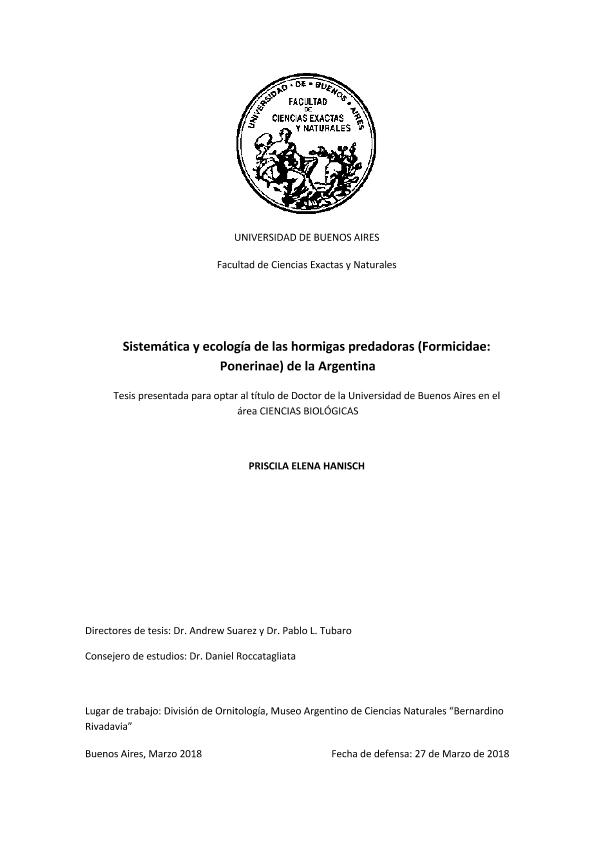Tesis doctoral
Las hormigas son uno de los grupos de insectos más abundantes en los ecosistemas terrestres, siendo sus actividades, muy importantes para el ecosistema. En esta tesis se estudiaron de forma integral la sistemática y ecología de una subfamilia de hormigas, las ponerinas. Esta subfamilia predomina en regiones tropicales y neotropicales, estando presente en Argentina desde el norte hasta la provincia de Buenos Aires. Se utilizó un enfoque integrador, combinando análisis genéticos con morfológicos para estudiar su diversidad, en combinación con estudios ecológicos y comportamentales para estudiar la dominancia, estructura de la comunidad y posición trófica de las Ponerinas. Los resultados sugieren que la diversidad es más alta de lo que se creía, tanto por que se encontraron nuevos registros durante la colecta de nuevo material, como porque nuestros análisis sugieren la presencia de especies crípticas. Adicionalmente, demostramos que en el PN Iguazú, dos ponerinas: Dinoponera australis y Pachycondyla striata son componentes dominantes en la comunidad de hormigas. Análisis de isótopos estables revelaron que la mayoría de las Ponerinas ocupan niveles tróficos altos, con excepción de algunas especies arborícolas del género Neoponera que dependerían de néctar u otros recursos vegetales. Por otro lado, nuestros resultados sugieren que la especie arborícola Platythyrea pilosula es un depredador especializado y tiene uno de los mayores valores de δ15N de cualquier especie de hormiga en el PN Iguazú. Finalmente, comprobamos la fidelidad de forrajeo para D. australis, una estrategia que le ayudaría a maximizar la obtención de comida. En conclusión, esta tesis brinda una importante información sobre la diversidad, distribución y el papel ecológico de la subfamilia Ponerinae. Ants are one of the most abundant insect groups in terrestrial ecosystems, and their activities are very important for the ecosystem. In this thesis, we studied comprehensively, the systematics and ecology of one ant subfamily: Ponerinae. This subfamily predominates in tropical and Neotropical regions, being present in Argentina from the north to Buenos Aires province. We applied an integrative approach, combining genetic and morphological analyzes to study their diversity, in combination with ecologic and behavioral studies to study the dominance, community structure and trophic position of the ponerines. Our results suggest that diversity is higher than previously believed, both because new records were found during the collection of new material and because our analyses suggest the presence of cryptic species. Additionally, we showed that in the Iguazú national park, two ponerines: Dinoponera australis and Pachycondyla striata were dominant components in the ant community. Stable isotope analysis revealed that most Ponerinae species occupied high trophic levels (primary and secondary predators), but some species overlapped with known insect herbivores. These low trophic level species were primarily arboreal Neoponera, and may rely heavily on nectar or other plant based resources in their diet. In contrast, field observations and isotope analysis suggest that the arboreal Platythyrea pilosula is a specialized predator, and has one of the highest δ15N value of any ant at Iguazú National Park. Finally, we proved the use of the fidelity of foraging routes for D. australis, a strategy that would help her to maximize prey harvesting. In conclusion, this thesis provides important information on the diversity and distribution of the ponerines and the ecological role of this subfamily.
Sistemática y ecología de las hormigas predadoras (Formicidae: Ponerinae) de la Argentina
Título:
Systematics and ecology of predatory ants (Formicidae: Ponerinae) of Argentina
Hanisch, Priscila Elena

Director:
Suarez, Andrew
Codirector:
Tubaro, Pablo Luis

Fecha de publicación:
27/03/2018
Idioma:
Español
Clasificación temática:
Resumen
Archivos asociados
Licencia
Identificadores
Colecciones
Tesis(MACNBR)
Tesis de MUSEO ARG.DE CS.NAT "BERNARDINO RIVADAVIA"
Tesis de MUSEO ARG.DE CS.NAT "BERNARDINO RIVADAVIA"
Citación
Hanisch, Priscila Elena; Suarez, Andrew; Tubaro, Pablo Luis; Sistemática y ecología de las hormigas predadoras (Formicidae: Ponerinae) de la Argentina; 27-3-2018
Compartir



